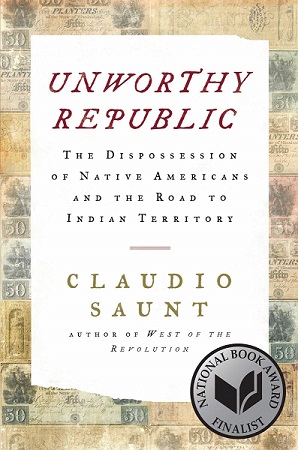
A National Book Award finalist in 2020, Unworthy Republic: The Dispossession of Native Americans and the Road to Indian Territory, by Claudio Saunt, is a deeply researched look into the priorities and policies that led to the state-sponsored expulsion of U.S. Native Americans from east of the Mississippi River to the west of the same.
In his forward, the author lays out three key points he will attempt to qualify:
First [the book] argues that the state administered mass expulsion of indigenous people was unprecedented. [snip] The U.S.-sponsored expulsion of the 1830s became something of a model for colonial empires around the world.
The second and related point made by this book is that the state-sponsored expulsion of the 1830s was a turning point for indigenous people and for the United States.
The expulsion of the indigenous people was far from inevitable [snip] It is not difficult to imagine alternative history. Congressmen who were opposed to federal spending, against the expansion of slavery, dedicated to Christianizing native peoples, hostile to Andrew Jackson, or simply reluctant to overturn current policy might have found common ground to join together temporarily to block the expulsion of Native Americans.
The first point, to me, is the most curious. As long as there have been invaders, these interlopers – to the US or elsewhere – have long pushed aside the native inhabitants – by deceit, force or by a show of (potential) cooperation. This happened with Indians in Maine, Massachusetts and elsewhere.
But in the south – where most of the mass expulsion took place – it took official government policy to remove the great number of Native Americans from that area. Not just some redneck with a musket. Official policy.
That was different. And not in a good way.
The book was not what I was expecting – I wanted to know more about why Indian reservations are sovereign nations and so on. Didn’t get much of this here.
And the book is so well researched that it was a difficult read. Most histories will say something about what the good or bad guys did, and then give an example.
Saunt will lay out a dozen examples. Great research and reference, but too dense for what I wanted, which is more of a 10,000 foot view.
Glad I read the book, but it was a tough read.
And I still need to read a “Native Americans for Dummies” book so I can get answers to questions I have, but that’s another day.
